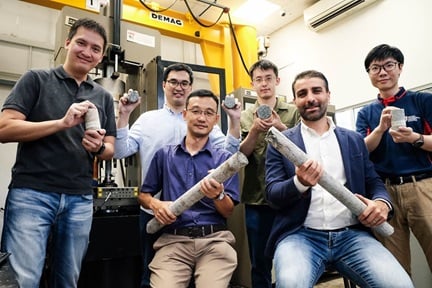Vortec's inventor, ERI@N co-director Choo Fook Hoong (left) a leading expert in the field of energy management, data analytics and air-conditioning systems, with Allan Lim (right, Business Development Manager at Vortec) .
Researchers at the Nanyang Technological University, Singapore (NTU Singapore) have developed the UFO-shaped ceiling fan that uses half the energy of a conventional fan to cool a small room twice as quickly. The fan is launched by Vortec, the spin-off company from NTU Singapore.
Named Vortec, the fan works by drawing the cooler air up from below the fan, wicking away heat and moisture from those sitting underneath it so they feel cool. Then the fan throws the air outwards from the top of the spinning vortex to create an air curtain that falls and cools people at the periphery with its circular airflow. Since it does not have any exposed fan blades, the fan is safe to touch even when spinning at high speeds. This also enables it to be mounted lower than conventional fans on the ceiling.
Conventional fans with multiple blades only blow air downwards, and those who are at the peripheries of its range won’t feel as cool as people underneath it. Also, a typical ceiling fan consumes about 75 watts, compared to the 42 watts of the Vortec ceiling fan, which due to its dual airflow, generates twice as much air movement, at about 100 cubic meters per minute.
The new ceiling fan is equipped with an LED lamp in the center that provides light in different temperatures of white and an ultraviolet (UV) light source. It helps to kill micro-organisms such as bacteria and viruses that may contaminate the fan and reduce the spread of diseases through the air in confined spaces.
During the lab test, the UV LED lamps produced by Seoul Viosys – a global inventor of UV LED products and technology which are used widely for sterilization and disinfection purposes – successfully achieved 99.9% sterilization of the coronavirus (COVID-19).
When used in conjunction with the building’s Passive Displacement Ventilation System, the Connect71 Co-Op Café at the NTU Innovation Centre, which is the size of a four-room apartment (90 sqm), managed to reduce utility costs by an estimated 50%. The efficient circulation and volume of wind from the Vortec ceiling fan had cooled down their customers without disrupting the café ambiance due to its silent operations, at an optimal 23 degrees Celsius.
“The fans seamlessly blend into the background of the cafe, are visually aesthetic, and add value to the interior design look we were going for. They also help the café to keep up with the technologically sophisticated ambiance of the Innovation Centre where we are situated,” said NTU student Crystal Mak who works as a Manager at Connect71 Café, reviewed the new fans after they were installed for a month.















/enri-thumbnails/careeropportunities1f0caf1c-a12d-479c-be7c-3c04e085c617.tmb-mega-menu.jpg?Culture=en&sfvrsn=d7261e3b_1)

/cradle-thumbnails/research-capabilities1516d0ba63aa44f0b4ee77a8c05263b2.tmb-mega-menu.jpg?Culture=en&sfvrsn=1bc94f8_1)






